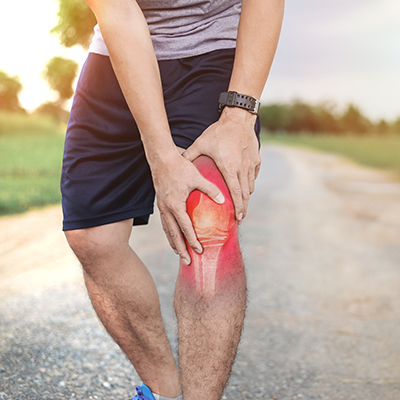10 Common Running Injuries and Why They Occur
Posted June 27, 2023 by By Greg Schimmoeller, PT, and Chris Miloscia, PT

With everything it takes to train for a marathon, the last thing you need is for a running injury to throw a wrench in your routine. But a recent sports medicine study1 shows that an estimated 30 percent of runners training for a marathon suffer some kind of injury. Types of injuries vary, but 10 common ones include:
- IT band syndrome
Occurs when the iliotibial band, rubs against your hip or knee bones, it gets swollen and irritated, leading to lateral knee pain as the primary symptom. - Back pain
Can be caused by poor running form and/or compensation from weakness or injuries in other parts of the body. - Knee pain/runners knee
Usually due to poor tracking of the patella. Responds well to hip abductor, core and quad strengthening. - Plantarfasciitis
Results in pain in the heel and bottom of the foot due to inflammation of a thick band of tissue that runs across the bottom of each foot and connects the heel bone to the toes (plantar fascia). Generally due to tight calf muscles. - Piriformis syndrome
Causes pain in the buttock which may radiate down the leg. Piriformis syndrome occurs when the piriformis muscle compresses or pinches the sciatic nerve. - Achilles tendonitis/tendinosis
Pain, inflammation and swelling of the Achilles tendon in the back of the heel and ankle area. - Medial tibial stress syndrome (MTSS)
MTSS is what many refer to as shin splints. Shin splints are pain and inflammation along the shin bone (the tibia) due to repetitive stress on the bone and the surrounding muscles and tissues. - Hamstring strain/tendinopathy
Strain or tear to muscles or tendons at the back of the thigh. It is usually caused by a sudden movement or injury that stretches or tears the muscle fiber. Symptoms could include pain, swelling or bruising on the back of the thigh, High hamstring tendinopathy is pain near the sitting bone. - Hip adductor and hip flexor strains
Hip adductor (groin) strain is a strain or tear to muscles or tendons on the inside of the thigh resulting in on the inside of hip and thigh. Hip flexor strain is a strain or tear to muscles or tendons on the front of the thigh resulting in on the front of hip and thigh. - Stress fractures and stress reactions
Result of accumulated injury from repeated submaximal loading, such as running or jumping. Occurs most frequently in weight-bearing bones (tibia, fibula, femur and bones of the foot).
Why Running Injuries Occur
The reasons for these types of injuries can be even longer than the list of conditions itself. Some runners build miles too quickly or attempt to change running form without proper guidance. Others may repeat hard workouts without easy workouts in between. And still others may become injured due to:
- Improper shoe type and excess shoe mileage
- A change of training surface
- Inconsistent training or overtraining
- A weakness of supporting muscle groups leading to compensation and increased stress in other areas
- Decreased flexibility of muscles
- Chronic malnutrition or dehydration for the individual
Injury Treatment
Fortunately, most running injuries can be relieved with the following treatment strategies:
- Massage the area (hands, foam roller, tennis ball, massage tools).
- Focus on strengthening the area, the joints above and below and hip and core.
- Stretching
- Ice (15-20 minutes) and/or ice massage two times a day.
- Rest
However, if you experience the following, you may need more advanced treatment to resolve your running injury.
- Extreme tenderness lasts 48 hours
- Injury alters your normal running form
- Pain keeps you awake at night
- Ice, rest and elevation have not decreased the swelling and pain in 48 hours
- “Nagging” injury lasts more than two weeks or has progressed each run
Talk to your healthcare provider about a referral to physical therapy. Physical therapy does not mean that you will have to stop running. Therapists will work with you to address the injury and get you back to running as soon as possible. In fact, PT offers a variety of treatment techniques, like video gait analysis, to get you better quicker than just rest and medications.
To learn more, schedule an appointment with one of the running injury specialists at Summa Health Therapy Services. Call 234.312.2358 or visit summahealth.org/therapy.
Greg Schimmoeller, PT
Director, Outpatient Therapy Services
Chris Miloscia, PT
Senior Physical Therapist
1. https://pubmed.ncbi.nlm.nih.gov/31855590/: Mohseni MM, Filmalter SE, Taylor WC, Vadeboncoeur TF, Thomas CS. Factors Associated With Half- and Full-Marathon Race-Related Injuries: A 3-Year Review. Clin J Sport Med. 2021 Sep 1;31(5):e277-e286. doi: 10.1097/JSM.0000000000000775. PMID: 31855590.
About the Author
Vitality eNews Sign Up
Receive the Summa Health eNewsletter for the latest health tips, advice and updates.
